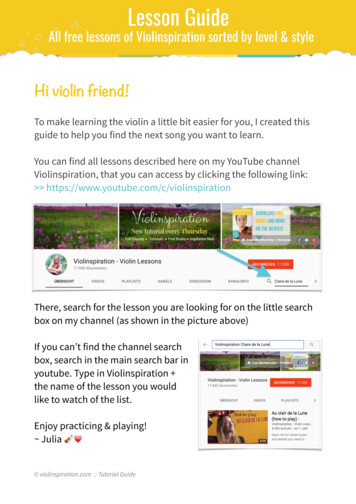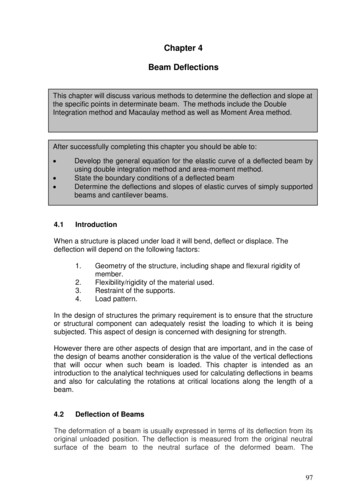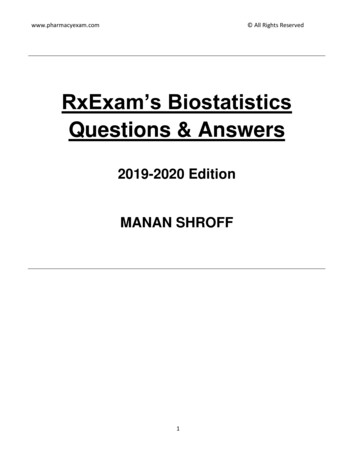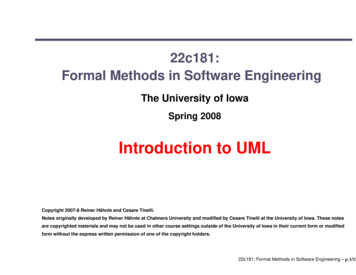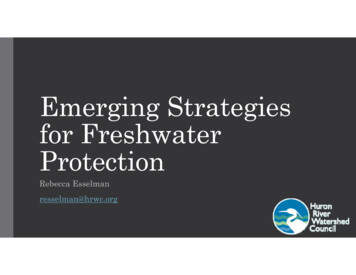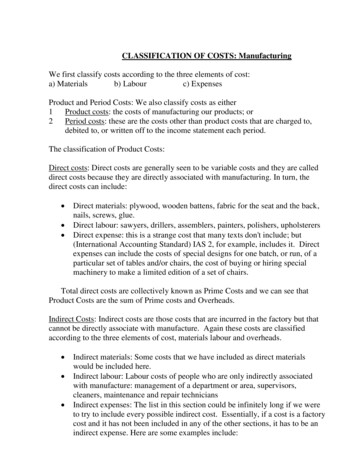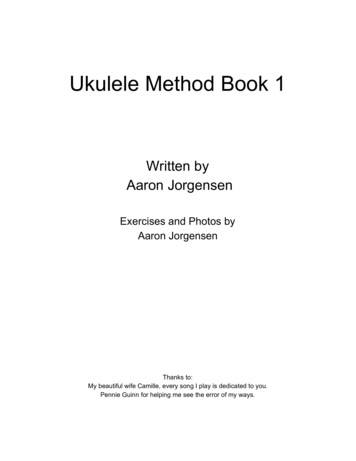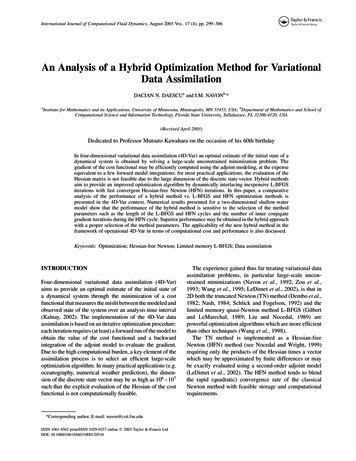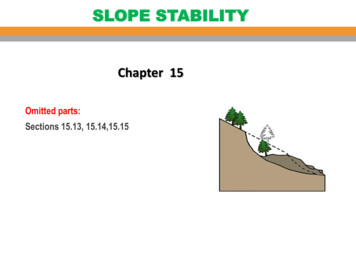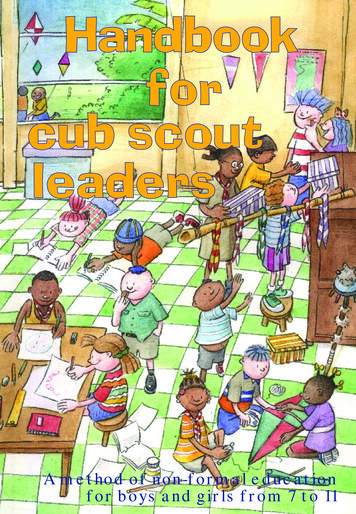
Transcription
A method of non-formal educationfor boys and girls from 7 to 11
416
All rights reserved.No part of this publication may betranslated or adapted into any language,or reproduced, stored,or transmitted by any means whatsoever,including illustrations and cover designs,without the express written permission of theInteramerican Scout Office,which represents the owners of the copyright.Reservation of rights applies equallyto the National Scout Associations which are membersof the World Organization of the Scout Movement.Copyright registration: 102.636ISBN: 956-7574-25-1This first edition of 3,000 copieswas printed in December 1998.Interamerican Scout OfficeAv. Lyon 1085, Providencia, Santiago, Chile, 6650426tel. (56 2) 225 75 61fax (56 2) 225 65 51e-mail: wscout@interam.cnt.clWorld Organization of the Scout Movement
PrefaceThe publication of Macpro in 1995 brought the world programmepolicy into an operational phase. In this the Interamerican Region has played apioneering role. For the first time in a long time, we have in our hands concreteeducational tools based on a solid theoretical approach.A short time after the emergence of Macpro, and inspired by its ideas,the European Region created RAP. This is a method intended to help Europeannational associations to define their own educational proposals, objectives,progress systems and their methods for each section, in a multicultural context.Taking inspiration from these beginnings, the World Bureau published the Guideto Programme Development at about the same time, closing a circle around thesame valuable set of ideas.With the publication of the Handbook for Cub Scout Leaders, theInteramerican Region has now embarked on a new stage: the Macpro-RAPapproach comes into field use at the level of the Cub Section. It speaks directlyto the leaders who work with boys and girls. It is a practical tool, for usingdirectly in the day-to-day work in the Pack. The Handbook draws its solidapproach from the very source of Scouting itself. Without a doubt, it will befavourably received and used in numerous associations.Do we mean to say that these publications are intended to relieve theassociations of the responsibility of developing their own programme? Are wecontradicting ourselves, by offering these publications on the one hand and, onother other, saying they should do their best to develop their own programmes?Certainly not! Each national association must work to improve and adapt thetools in the light of their own particular needs, as far as their possibiities andresources allow. However, we know that this is an arduous and difficult task,just as we know that it would be ridiculous to have everyone reinvent the wheelin their own corner of the world. Is this not one of the foremost missions of theWorld Organization of the Scout Movement, to offer the national associationsthe opportunity to benefit from a permanent network which is busy at worldlevel exchanging ideas, experiences and educational materials created by someor other of the network’s participants?
It is this principle which has led to the publication of the Handbook forCub Scout Leaders in English.Some associations will choose to make it available to their leaders justas it is, seeing that it responds to needs which they have already identified.This is the case of the English-speaking associations of the Caribbean, in whosecultural environment many of the beautiful illustrations of this book have foundinspiration.Other associations will decide to adapt the book to bring it closerto their own particular situation. I am thinking, for example, of the newassociations which are constantly emerging in different parts of the world.Finally, there will be associations which will limit themselves tomaking it available to their national teams, as an example of a tool which hassuccessfully taken programme policy into the field, or as a complementary toolfor developing their own programme.However it is used, no association or leader who is concerned aboutrenewing programme can let this book go by without noticing it, readingit, renewing some of his or her points of view and using it to help improveprogramme in the Cub Section. There is no doubt that, at the very least, thisbook will greatly enrich the variety of tools available to associations today forputting the world programme policy into practice.The Interamerican Region and the European Region are alreadyworking on a similar project for the Scout Section. In this way, we are busydeveloping active inter-regional cooperation. Our ambition is clear: to join ourforces even more powerfully to reach our shared objective of “better Scoutingfor much more young people”.Dominique BénardRegional DirectorEuropean Scout Office
IntroductionThe content, language and style of this book have been designed toencourage the reader to think long and hard about what it means to educatechildren.It is a book designed to highlight the importance of contributing tothe development of all the dimensions of a child’s personality. It explains anon-confrontational, non-formal educational process which makes the mostof the special time available in leisure hours.A book written thinking about children, but intended for theirleaders. These adults and young people are invited to grow in their task asvoluntary educators, approaching it cheerfully and responsibly.A text for frequent use, it offers practical guidelines and tools andhelps leaders to do things efficiently. But more than that, it asks us to thinkabout the things that we do. If we understand the reasoning behind what wedo as leaders, it will be much easier to distinguish between what we do andhow we do it. This is the key to constantly renewing the means we use tokeep pace with modern educational thought, while staying true to the valuesthat inspire us.A book written thinking about boys and gilrs, men and women, sinceeveryday there are more reasons for working together and fewer pretexts fornot doing so. Working together, acknowledging each other as the same butdifferent. Taking all due care, but nevertheless acting decisively, leaving asidethe misbreak and prejudices which sometimes prevent us seeing clearly.Working together and opening our minds to diversity. This handbookis intentionally designed to be equally useful for mixed packs and sixes,for mixed packs with single sex sixes or for single sex packs within a scoutgroup.Diverse alternatives which use the same method, the sameinspirational background, the same programme system, the same names andsymbols and the same support material for the leaders and children.The same method, because there has only ever been one scoutmethod, although parts of it have sometimes been given different names.
The same fantasy environment to motivate learning: the fable of the freepeople of the wolves. After many efforts to invent another as good, the educationalexperience of almost a century has shown that Kipling’s tale is equally relevant forgirls and boys.The same programme system, which invites the children to take onpersonal growth objectives. It also encourages the creation of varied activities,of the children’s own choice, which give them experiences which help them toachieve their objectives.The same names and symbols, which facilitate integration both amongpacks and among countries. Boys and girls, from one neighbourhood to another,from one culture or nation to another, can share their experiences in a genuineinternational scout family.Using the same names also enables us to work together on producing texts.Working together enables us to raise quality and lower costs. It is thanks to jointefforts that we have this Handbook today for cub scout leaders and four Bookletsfor children.The book is also an effort to reconcile continuity and change. It hasbeen produced by men and women from different countries who have sat downtogether around a table to put forward their ideas and listen to each other. Thisopen exchange has enabled us to recover our roots and at the same time widenour vision to the open future. It has given us the opportunity to try out responses tothe problems of today and to the questions of tomorrow which are waiting in thewings.It is clear that the authors of the book have adhered closely to the regionalpolicy of the Interamerican Scout Organization, especially in regard to themethod for the creation and continual updating of the youth programme, knownas Macpro. Working on this solid foundation gives the book consistency andmakes the different areas of it work together smoothly. This clear orientation haskept it firmly on course, preventing it losing direction in the search for a way ofharmonising tradition with modernity.In addition, the friendly language, the logical sequence of the subjects andthe flexibility of the proposals help a well intentioned person who is young at heartand has a basic educational attitude, to take on the task of working with a team ofpack leaders, even if he or she has never been a scout leader before. And sooner orlater, this should bring the good news of more and better leaders.You are cordially invited to read this handbook and consult it as often asyou like.Regional Director, ISO
ContentsChapter 1Boys and girlsfrom 7 to 11Chapter 2Group lifein the packChapter 3A symbolic frameworkChapter 4Team systemChapter 5The role of the leadersin the packChapter 11The programme cyclepage 189Chapter 12Assessing the packand preparinga proposalpage 199Chapter 13Proposing and selectingactivitiespage 211Chapter 14Organising,designing and preparingthe activitiespage 225page 7page 19page 31page 53page 69Chapter 15Chapter 6The educational proposalChapter 8The growth areaspage 81page 107Chapter 9The educational objectives page 125Chapter 10The educationalCarrying out and evaluatingthe activitiespage 239Chapter 17Celebrationsin the packpage 275Chapter 18PackAppendixGlossarypage 297
1chapterBoys and girlsfrom 7 to 11
We usually have a good idea ofwhat girls and boys are like at this age,without giving it too much thoughtAlmost all of us have ageneral idea about whatgirls and boys from 7 to 11are like: it is one of thestages of life we knowbest, so much so that whenwe talk about childhood weare usually thinking aboutthis age group.There are severalreasons for this:Our clearest memories of our own childhood date from this period.They are usually pleasant memories, since the love and attentionmost of us receive during these years mean that we remember themas some of the nicest times of our lives.This is the period in which parents begin to see their owncharacteristics reflected in their children, and this makes them payeven more attention to their development.It is a period of great stability, since after the rapid growth of theearlier years, from 6 or 7 onwards children become more balancedand harmonious both physically and emotionally. With fewexceptions, this lasts until almost 10 in girls and almost 11 in boys,and it has the effect of making them very attractive and pleasant tobe around, affording endless joy and satisfaction.At this stage children have boundless energy and very often try tomake things go their own way. This means we have to be constantlyalert to their demands and the risks they may take without realising.8
All this generally well known background means that when we arefacing the prospect of working with a pack as a cub scout leader or an assistantleader, we think that we are well prepared for it.Moreover, during this period children tend to be quite open and arealmost always willing to join in with any scheme we might suggest, except foroccasional shyness or failure on our part to provide the right encouragement.This only serves to strengthen our conviction that we understand them and thatwe are playing our part very well.This kind ofknowledgeis very useful,but it’s not enoughifThe general knowledge we all have aboutthis age group can lull us into thinking that weknow enough to be working with children, evenwe realise that we lack depth of knowledge incertain aspects.However, in order to fully understand theirinterests, to be able to offer them attractiveactivities and to assess their personal development,it is essential to have access to wider informationand a more thorough knowledge of boys and girlsfrom 7 to 11.Such knowledge should cover everything thatcontributes to the make-up of a child’s personality:their physical growth, intellectual development,character, emotions and feelings, their attitude toothers, their idea of God and many other factorsthat help us to understand this age group.This information can be found in many kinds of books, in different formsand degrees of detail. The book Childhood published by the InteramericanScout Organization is a good source of background knowledge and should beavailable in the association.In the meantime, until you have read and absorbed thatbook, the following brief summary of the different aspects ofthe personality in children of this age group may be helpful.9
A roughprofileof boys and girlsfrom 7 to 11The boys andgirls in your packare always active andfull of energy. They may haverun around and played all day, butthey’re certainly not ready for bed - and thenthey’ll be too tired to get up. except when you’redesperate for some sleep. The usual story in camp.They don’t grow particularly fast, they don’t eatall that much, they won’t wash without being told, theycan’t resist the temptation of trying out a new sport andit never occurs to them that you might be tired just whenthey think up some new source of adventure.10
Coming up with new questions and newanswers is part of the game of life at this age.Surprises, discoveries and new and useful factsare part of everyday life.Children are great observers of nature and theworld around them, they invent gadgets and tools,they will attempt to build anything and will alwaysinsist on having their curiosity satisfied.11
They will strongly defend what they perceive tobe right and fair with regard to the concrete issues theyunderstand. They will not forgive cheating at a game orunfair distribution of something. and any injustice willbe insistently pointed out by the one who feels unfairlytreated. However, little by little, they will also begin toconsider the opinions and interests of others and will learnthat they can’t always have their own way.They will begin to commit themselves to small tasksand try to meet those commitments, and although theymay fail a dozen times, they will gradually learn whatcommitment means.By the end of this period they no longer look tofigures of authority to answer questions "just because"they are figures of authority. Instead, they will ask peoplethey have learned to respect because they know they willreceive honest and straightforward answers.12
Their state of mind is generally stable, a constantfactor in the development of their personality. Thisstablility is only rocked by strong or conflictingemotions, and even these vanish as quickly as theyappeared. The joy of a happy moment, the sadnessor indignation at a failure, the excitement of the newor boredom of the routine, are shared with family,friends and cub leaders naturally and spontaneously,sometimes quite irreverently.The way adult opinion is received may vary,sometimes it will count more and other times less.However, in general, adult intervention can onlybriefly influence emotions and behaviour. Repeatedintervention will often be necessary.13
Although children show their individualism in manyways, they are capable of playing with each other andco-existing within a framework of rules and norms whichorder life in a group. Little by little, these rules and normsbecome accepted, as the children themselves learn toimpose them with the help of adults. Of course, adultsmust also be prepared to stick to them. These rules willbe applied to the most apparently trivial details and themost unlikely situations you could think of and, oncethey are established, children will insist that they are kept,especially if they are affected personally.The discovery that there are people among theirfriends, parents and teachers who hold different opinionsto their own, and that reaching a consensus and gettingalong together is an integral part of life, is just as muchof a novelty to children as discovering nature, the worldaround them and other places and cultures. This discoveryof different attitudes will be the basis of learning toleranceand respect for others and for different ways of life.14
Ever curious about the idea of God, during thisperiod children want to know more about Him.Depending on the family, the culture, the schooland the child’s own environment, they will begin todiscover Him and to build a personal relationship withHim, as a friend, a brother who can help and a fatherwho protects and who they learn to love.Just as they would with any other friend, they willwant to know where He came from, what His storyis and what He thinks, and they will be willing to dowhat He asks. But they will also ask Him for things,thank Him for what they receive and think of Him atemotional moments.1515
Girls and boysjust the same, but different tooAnatomically speaking, with the exception of the reproductivesystems, there are few differences between girls and boys from 7 to 11, orat least the differences are almost imperceptible at first sight. They are alsophysiologically similar at this stage, since it is only towards the end of it-about 10 or 11- that the hormonal changes which trigger the beginning ofadolescence and which mark the fundamental differences between men andwomen begin to appear.However, in spite of this basic similarity, there are some differences tobe seen in the features, behaviour, attitudes and interests of boys and girls.Why these differences exist is open to debate: some say, for example,that rough and aggressive behaviour in boys is innate while girls aregenetically programmed to be sweet and gentle. However, nowadays it isgenerally accepted that both types of behaviour are acquired and stem almostentirely from the environment in which boys and girls have been brought upand the specific models of male and female behaviour with which they cometo identify.The strongly "cultural" origin of these differences is closely relatedto the stereotypes which exist in our society. Although equality of rights andopportunities for men and women has come a long way -on paper at leastquite marked stereotypes of what is considered masculine and feminine arestill widely prevalent.In the pack we should avoid letting ourselves be conditioned by thesestereotypes and try to prevent situations which encourage them, such as boyscarrying out challenging leadership activities, while the more passive andsubservient tasks are reserved for the girls.Although we should try not to be influenced by stereotypes, it isobvious that some gender-linked differences between men and women doexist, but at this age they are fewer than is commonly believed.This is why we say that boys and girls are the same but differenttoo. And this is why we should not try to create a "unisex" educationalenvironment in which being a boy or a girl makes no difference, and in whichthe pursuit of equal rights between the sexes makes us forget the differencesbetween them and the ways in which they complement each other.16
Moreover, our view is that it is important to incorporate this differenceinto the educational climate, picking out and highlighting the infinite potentialof being a man or of being a woman. Just as the fact that there are differencesbetween men and women does not have to mean that they are antagonisticto each other, equality of opportunities does not necessarily have to meangeometric uniformity.The educational process should treat boys and girls as equals in terms ofrights and should guarantee their opportunity to develop their full potential. Thismeans encouraging boys and girls to learn more about each other, to respecttheir differences and appreciate the ways in which the sexes complement eachother. Moreover, each boy or girl should have the freedom to develop theirindividual interests, without any particular type of behaviour being classified asinappropriate for their sex.The educational process must consider and respect the differencesbetween men and women in the same way as we would expect it to respect anyother kind of difference between human beings.In order to develop an educational process which is able to respect bothequality and difference, it is essential that as parents, teachers and youth leaderswe act in agreement with each other.Having some general knowledgeabout boys and girls from 7 to 11and recognising them asthe same but different too is very usefulBut thatis still not enough:you must alsoknow each oneas an individualTo understand oneparticular child, with a face anda name, it is not enough to knowwhat boys and girls are generallylike from 7 to 11.17
You also need to know what he or she is like as an individual. He orshe is a unique human being whose personality may conform in general termsto the characteristics of the age group, but it also has particular features whichmake it unique and which depend on the child’s genetic make-up, the homethey were born into, their place in the family, the school they attend, theirfriends, and life events. Each has their own story and individual reality.No books, courses or manuals will ever be enoughto give you this sort of knowledge about the boys and girlsin the pack - especially the ones whose development you monitorand assess. The only way is to spend time with them and observethem, get to know their environment, share different momentswith them, see their reactions, understand their frustrations, listento their feelings, discover their ambitions: in short, to discovereach one as a person.This is your first task and whether or not you succeeddepends on the quality of the relationship you create with eachboy or girl. An educational relationship which will demand of youinterest, respect and love.18
chapter2Group lifein the pack
The pack isa special environmentwhere girls and boysform a friendly groupwhich has fun and does interesting thingsNow that we know what boys and girls are like at this age and weare willing to get to know each one of them as an individual, we have tothink about the environment we are inviting them into, about the quality andattractiveness of the group life in the pack.Group life is the sum of everything that happens in the pack and therelationships that develop between its members.The special atmosphere in the pack results from a combination of things: the attractive activities, the enjoyment of sharing things in small groups, the challenge of life in the outdoors, the joy in helping other people, democratic decision-making, developing rules to govern life together, the sense of belonging that comes from the symbols, the meaning of thecelebrations, the games, songs and dances. In short, everything that happensin the pack.Part of that atmosphere is the way in which each individual is welcomedinto it, the warm relationships that are created with the leaders and the carethat is taken to help each girl and boy to reach their own personal developmentgoals. In the process each child should come to feel that they are an importantpart of that environment, of that special place in which a groupof friendly people has fun and does interesting things.It is essential to grasp this to understand the attractionthat scouting holds for young people. If the group life is good,children come and stay. If it’s not, they may come but they won’tall stay. Some of them may stay, because even "poor" group life cansatisfy some of a child’s needs. However, in that case the pack is notmaking the most of the scout method’s possibilities to enrich grouplife and help children to give the best of themselves.20
This special environmentis also an educational spacewhere lifestyles are definedThe environment created by group life is like a stage for rehearsing futurelife in society, one which encourages close, natural and respectful relationships andwhich prepares for adult life. It is an enjoyable environment in which values areabsorbed and which provides opportunities for personal growth and development.What is different about scouting in educational terms is that each boyand girl experiences that environment as a game. Nevertheless, immersed in thatenvironment, almost without realising, they become used to a certain way of doingthings which little by little makes an impression on their young lives, enabling themto define their personality and build their own scale of values.This is a learning process which happens naturally: it is non-confrontational,not based on classes or lessons, the need to memorise or explain, or prizes orpunishments. The children are accompanied throughout the process by leaders whohelp them the way an older brother or sister would.This means that group life itself is the truly educational factor at work in thepack, since it brings together and interweaves all the elements of the scout method.What is group life made up of?All the elements of the scout method -which you will discover in atheoretical context in courses and handbooks- come together in real life "in thefield" through the constant actionof group life, rather as it is shownin the following diagram.In this diagramthere are threegroups of elements:21
Firstly,the people:the children, the leadersand the relationship between themAt the top of the diagram are the girls and boys;and at the bottom are the leaders, adults or young adultswith the arrows representing a two-way relationship between them.22
There are several importantideas involved here:The central roleof the educational interests and needs ofthe children in the scout methodthe stimulating adult presencei.e. the leaders-adults and young adultswho are at the bottom of the diagram,symbolising their supportiverather than authoritative rolethe contribution whichthe girls and boysmake to group lifewhether individuallyor in their small groups,which are usually knownas the team systemthe interactive educationalrelationship betweenchildren and leaders,working togetherat all times.23
Secondly,what people want to achieve:the educational objectivesand the activities which help reach themAt the sides of the diagram are the activities on the leftand the children’s personal development objectives on the right,joined by arrows showing the relationship between them.24
This means:That everything in the packis done by means of activitiesin line with the principleof learning by doing;that girls and boys are asked tocommit themselves to educational objectiveswhich at this age are presented by the leadersand agreed upon with theactive participation of the children;that the activities give the children the personal experiencewhich little by little, through group life,enables them to achieve these objectiveswith the help and mediation of the leaders.25
Thirdly,how they propose to achieve it:the other elementsof the scout methodIn the centre part of the diagramare all the other elements of the methodinterrelated in an active circle26
Life in naturea fundamental element of the methodand a special environment in which to carry outmany of the pack’s activities.The pack lawwhich sets outthe principles that guide usin a way that is easyfor children to understand;and the promise a commitment that they freely maketo always try to do their bestand live according to the law.Service to othersthrough both individual good turnsand the activities of servicewhich the children carry out as a group;the pack’s symbolic frameworkwith its symbolsand celebrationsinspired by the storyof the free people of the wolveslearning through playing,an element which, on the one hand, helpschildren to become integrated into group life,and, on the other, shows themwhat group life is aboutand enables them to internalise it through play.We will talk about all the parts of this diagram in different chaptersof this guide, and take a more detailed look at how they work and relateto each other in practice.27
Group lifein a few wordsGroup life is the atmospherein the pack.This is the environment in which the children grow,reach their objectivesand develop their own way of doing things.The quality of group life is the keyto making the pack attractive for children.For the children, group life will always be a game,as natural as the air they breathe,but, as leaders, we know that the quality of group lifedepends on how well all the elements of the scout methodare put into practice in the pack.No activity will ever reach objectives on its own;it will only work in conjunction with these elementsand by making them part of group life.The quality and richness of the group lifeis one of your fundamental responsibilities as a leader.28
29Group lifewithout words
We now have a clearer idea about what children aregenerally like between 7 and 11, we know that there isalways more to be learned about them and we are awarethat we have to make an effort to get to know each one as anindividual.We also know about the atmosphere that our packshould have and how important each of the elements of thescout method are for achieving that.Now we can go a little further and venture intothe jungle, where we will meet the attractivecharacters that help to create that atmosphere.30
chapter3A symbolicframework
A fantasy worldserves as an inspirational backgroundfor group life in the packThe environment in the pack which we talked about in thelast chapter is illustrated by a fantasy world which makes use ofthe way that children think, to develop scouting’s proposal in away that is easy for them to understand.Once again we must refer to play. From 7 to 11 thecreative powers of the imagination are all-powerful and
With the publication of the Handbook for Cub Scout Leaders, the Interamerican Region has now embarked on a new stage: the Macpro-RAP approach comes into field use at the level of the Cub Section. It speaks directly to the leaders who work with boys and girls. It is a practical too


